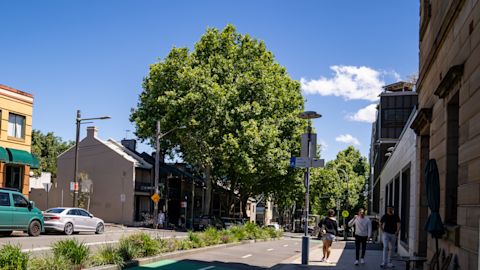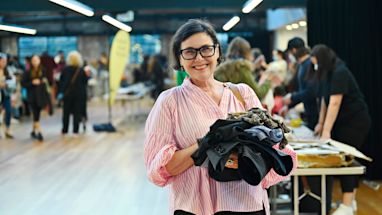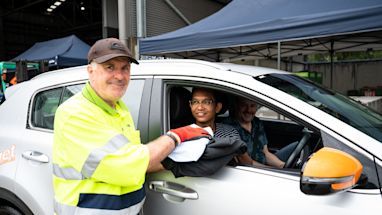The street tree master plan is a critical tool to manage our urban forest. Our updated plan is open for feedback until 28 February 2023.
Here’s some things to know about the plan.
1. It guides future planting
We’ve developed a comprehensive list of tree species best suited to our local area.
If a certain type of street tree is proposed, it doesn’t mean we remove existing trees right away to plant new species.
Trees, like all living things, grow, age and eventually die. The plan helps us navigate where trees are planted and what species to use when they need replacing.

2. It’s been created by a team of experts – with input from our communities
The plan was created with feedback from our residents and businesses, specialist knowledge from street tree experts and experience gained from our 2011 master plan.
We asked the community for early feedback on the street trees in their local area.
We also engaged experts with a range of skill sets – arboriculture, urban forestry, landscape architecture, heritage, plant science and Indigenous ecology.
There are thousands of trees to choose from, but only a select set have been identified for street tree planting in our area.
We know people have strong feelings about street trees. And it’s important we get this right – no one person makes the decision.

3. Diversity is key
The new plan draws from 81 tree species compared to the 2011 plan with 68 species.
“We know people have particularly favourite trees but we need to make sure we have the right balance in terms of diversity and species so we can meet the needs of the community and deal with the impacts of climate change, including pest and disease issues,” City of Sydney urban forest manager, Karen Sweeney said.
This is also important to help urban ecology. We need to make sure our native animals and birds have access to a wide variety of species.
“It's like a healthy balanced diet when you think about it.”

4. There will be more natives – but we can’t plant only natives
Overall, we’re increasing locally indigenous tree species. There’ll be a change of species in around half of the streets in our area.
Cities can be tough places for trees to grow, with paved surfaces, compacted ground and buildings reflecting light and heat.
To meet current and future challenges facing our city, our urban forest will continue to include a mix of native and exotic tree species.
In residential areas and some city centre streets deciduous trees are extremely useful to maximise summer shade and winter light.
Both natives and exotics have strengths and weaknesses for use as street trees.
This plan aims to plant the right tree in the right place, for the right reason and strike an appropriate balance between native and non-native species.

5. First Nations knowledge is embedded in the plan
We’ve worked with an Indigenous ecologist to include more tree species that are indigenous to Sydney and nearby regions.
Ciaron Dunn is a Gumbaynggirr man living and working in Sydney and an ecologist who worked on the project.
“The street tree master plan gives the Aboriginal community an opportunity to step up with our representation.”
“It's important for me as an Aboriginal person to be involved in this, to represent my community, to represent our viewpoints and to put our mark on the planning processes within the City of Sydney,” Dunn said.
We’ve selected species that relate to the previous ecology of a specific area to assist with connecting with Country. And we’re reintroducing some iconic and locally indigenous trees in areas of heightened cultural significance such as the harbour’s edge and important civic places.

One to keep an eye out for are bloodwoods: red bloodwood (Corymbia gummifera) and the yellow bloodwood (Corymbia eximia). They are known for their heavy and gnarled bark and beautiful cream and yellow flowers.
“They're a reasonably hardy species, they're tall and upright before they spread. They're indigenous to the local area, and would have been around in the past. We’re trying to increase their usage including around the harbour edge,” Sweeney said.
7. We’re planting for those in our area now – and residents and climate conditions in the future
A tree must be able to thrive in a location, long term. “We would really like to be getting at least 40 years of life out of our street trees and in some situations 80 years.”
Georgina Street in Newtown is a heritage streetscape and a prime location for trees to be there for even longer.
"There's no reason why the trees that we are planting now aren't going to be still be growing in 100 years. There is some complexity, but if we've picked the right species, maintained them well, and if we haven't had issues with storms and diseases and other issues outside our control, because obviously, trees are living things as well, we will have a healthy and resilient urban forest," Sweeney said.

Part of this process has been reviewing our tree species list to ensure proposed trees are suitable and resilient for a changing climate. Research shows Sydney is modelled to have a climate like Grafton by 2050.
“We're on that trajectory already and we can already see that some species aren’t performing well. They're not thriving,” Sweeney said.
We're making sure trees we plant now can tolerate the heat, the drought and any high rainfall when it happens.
Some you will recognise, for example, jacarandas are on the street tree list. And they’re not just there for their looks Sweeney said.
“They provide excellent shade and most people love the visual interest of the flowers.” You might see more in Redfern in the future. “It's got really good soil there and quite wide streets in some cases, so they will provide that beautiful arching canopy over the roadway that people quite like.”
Another one to watch out for that’s suitable for planting with our changing climate is the Tulipwood (Harpullia pendula).
Originally from northern NSW, it's a rainforest native that also copes with drought and is dense and lush with pretty orange flowers and fruit.
“It's a nice sized medium tree that has proven to grow really well in Glebe. We've got some on Glebe Point Road, it's really dense and lush in terms of its look and feel. A lovely little tree!” Sweeney said.
One tree you will start seeing less of is the London plane tree (Platanus x acerifolia). Evidence shows it won’t be suitable for our area as our climate changes so we will look to plant more hardy species instead.

There is no perfect tree – but we do our best to pick the right tree for the right place, starting from the ground up.
“The first thing we do is we look at the soils in the area. Then we look at what's happening around it in terms of the built form because that governs how much space there is. Then we're trying to increase as much canopy as we possibly can. Then after that, it's about thinking about species diversity and climate resilience," Sweeney said.
“The big thing for us is to make sure that we're planning so that everyone gets to enjoy the beautiful, amazing benefits that trees provide."
Find out more and have your say on our revised street tree master plan until 28 February.
Published 6 February 2023, updated 14 February 2023



